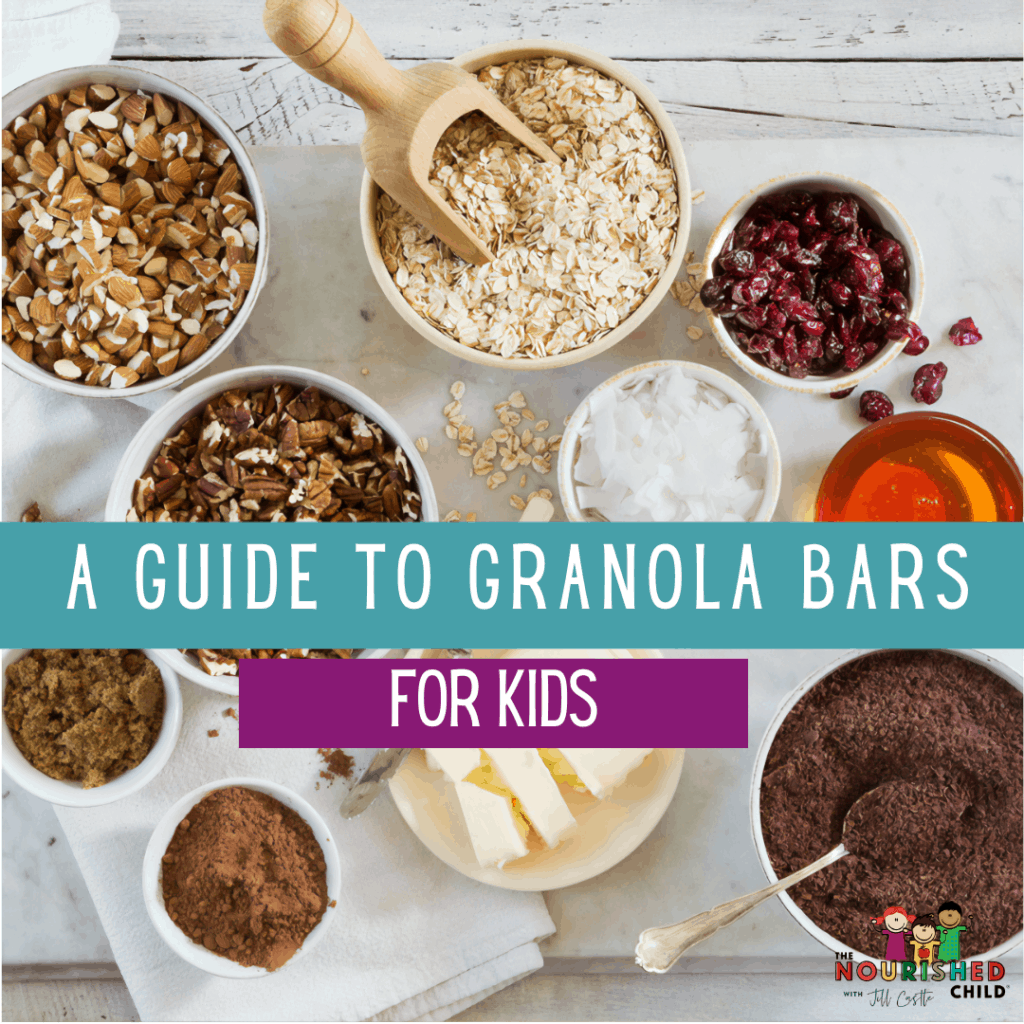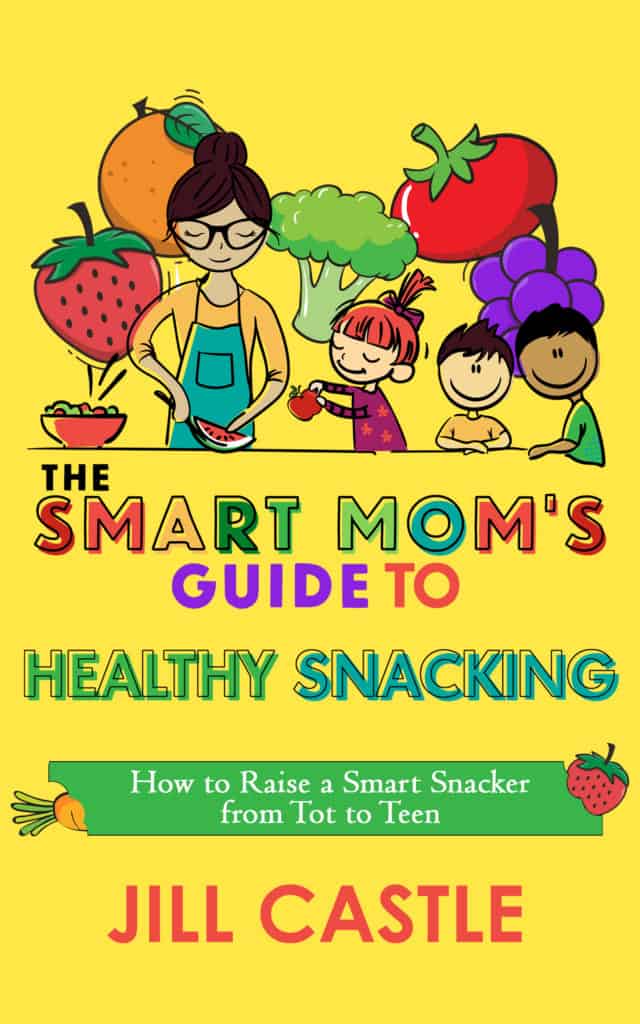How to Choose Healthy Granola Bars for Kids (Guide)
November 30, 2023
Learn how to pick a healthy granola bar for your child from the grocery store, and see which snack bars qualify as “good enough.”
Granola bars are one of the most popular snacks for kids. And they can be a great snack for kids, especially in a pinch.
They’re easy to stick in backpacks and lunch boxes, don’t require refrigeration, stay fresh for a long time, and come in individual packages with countless flavors to choose from.
What’s not to like?
But when you consider healthy snacks for kids, they don’t always make the list.
While they can be both nutritious and taste-friendly, they also can be a fat and sugar trap.
So how do you find healthy granola bars for kids?
First, look past the health claims on the box and turn it over to view the back side – the ingredients and the Nutrition Facts Panel.
I’ll show you what you should look for when choosing store-bought bars for kids.

Is a Commercial Granola Bar Healthy?
Let’s face it, not all granola bars are created equal.
And if you’re like most parents, you need a granola bar guide that helps you make the best choice for your child.
The variety and breadth of snack bars might amaze you when you walk through the cereal aisle. It’s quite a market!
You might even be overwhelmed by the many different bars for kids: crunchy, soft, chocolate- or peanut butter-dipped, high protein, high fiber, nut-free options, and more.
The granola bar aisle can make your head spin!
If not, it will at least make you question which one to buy.
Claims on the boxes such as “healthy”, “nature”, “fiber”, “TLC”, “organic” makes it even harder to choose a brand and flavor for your child.
How is a parent to know which claims are correct?
[Related]: Healthy Cereal for Kids [My Top 27]
The Healthiest Granola Bars: What to Look For
You can use the Nutrition Facts Label and the ingredient list on each package to help guide your choices.
First, scour the nutrition facts label to check for sugar, fat, sodium, and fiber; then look at the sources of these nutrients on the ingredient list.
I’ll break down what you need to know here:
Sugar
Did you know some granola bars have almost as much sugar as candy or a donut?
It’s easy to tell that granola bars covered in chocolate might be high in sugar.
But sometimes there’s hidden added sugar and the granola bar looks “healthy.”
Take a closer look at the labels to uncover what’s inside.
Nutrition labels now list the amount of added sugar separately so that you can see how much was added during processing compared to how much sugar naturally occurs in the food (fruit, lactose).
The 2020 Dietary Guidelines for Americans recommended kids get no more than 10% of their daily calories from added sugars.
That means an 8-year-old who eats about 1,800 calories a day should aim for less than 45g of added sugar per day.
One granola bar we reviewed had 9g of sugar… compare that to 12g of sugar found in a donut!
Health Tip: To keep the sugar in check, choose granola bars that have less than 10 grams of sugar per serving.
Granola Bar Calories
For the most part, families use granola bars as a snack, so the calories need to reflect the level of calories suitable for a child’s snack: about 100-200 calories.
Some granola bars have as many calories as a small meal and cannot justify themselves as a child’s snack.
Ideally, you don’t want to rely on granola bars as a meal replacement. It’s not a balanced meal with the variety of nutrients a growing child needs.
And granola bars aren’t a very satisfying meal.
Health Tip: To keep the calories in check, choose a granola bar with less than 180 calories per bar.
Fat
If you’ve ever made homemade granola bars, you know a considerable amount of fat—oil or butter—goes into these gooey treats to help bind the ingredients together.
Fat is a high-calorie nutrient (9 calories per gram versus 4 calories per gram for protein and carbohydrate).
So higher fat granola bars will inch up in calories.
Granola bars made with nuts will also be higher in fat, even though they are healthy fats (good for the heart).
That’s why it’s also important to compare the different types of fat listed on nutrition labels.
Saturated fats and trans-fats are two types of unhealthy fats to look out for.
Trans-fats are solid fats shown to contribute to heart disease and other chronic diseases.
A granola bar is a potentially healthy snack, but it loses its nutritional value when trans-fat is an ingredient.
While no trans-fat is the goal, you don’t have to eliminate saturated fats, or the animal fats that may be included.
However, the saturated fat content should be a consideration when choosing a granola bar.
Health Tip: Choose low-fat granola bars with 5 grams of fat or less per serving.
Fiber
Granola bars can have lots of fiber and be a good source in a child’s diet, considering the typical fiber intake of children, which is less than desired.
Here’s a guide to children’s estimated fiber needs. Fiber recommendations vary by age and gender.
| Age and Gender | Fiber grams/day |
| 1- 3 years old | 19g |
| 4 – 8 years old | 25g |
| Boys 9 – 13 years old | 31g |
| Girls 9 – 13 years old | 26g |
| Boys 14 – 19 years old | 38g |
| Girls 14 – 19 years old | 26g |
(Popcorn is another high-fiber snack option!)
Health Tip: Look for granola bars with more than 3 grams of fiber per serving (5 gm per serving is considered a high fiber item).
Granola Bars with Protein
You can find granola bars with a good source of protein (nuts, peanuts or dairy). Some have up to 5 or 6 grams of protein. You can also find bars made with whole grains, and some that are free from added chemical flavors and food colors or dyes.
Health Tip: Look for bars with a short list of ingredients.
Guidelines for Healthy Bars
To summarize what to look for in a snack bar for kids, follow these nutrition guidelines:
| Nutrition Facts | Healthy Guide for Granola Bars |
| Sugar | <10 gm per serving |
| Calories | <180 calories per bar |
| Fat | 5 gm or less per serving |
| Fiber | >3 gm per serving |
Healthy Store-Bought Granola Bars
Whether you send a granola bar as a mid-morning snack or offer them for sports practice, when you focus on a single nutrient such as sugar or fiber it’s easy to see how one granola bar compares in nutrient categories compared to its competitor.
We looked at the overall quality of randomly selected, kid-friendly granola bars when determining which were the best granola bars for kids.
Let’s look at two granola bars, one I consider nutritious, and the other, not so much, for comparison:
| Brand | Calories | Total Fat | Sat. Fat | Sugar | Sodium | Fiber | Calcium |
| Kashi TLC: Chewy Trail Mix | 140 | 5 g | 0.5 g | 5 g | 105 mg | 4 g | 0 mg |
| Hershey’s: Reese’s Sweet & Salty with Peanuts | 170 | 9 g | 2.5 g | 9 g | 180 mg | 2 g | 0 mg |
*Nutrition information obtained from www.calorieking.com.
Kashi TLC Chewy Trail Mix is low in saturated fat, has less sugar, and has a good amount of fiber.
Although its calorie content is on the higher side compared to some granola bars, it’s still a reasonable amount for a snack.
Add protein and calcium for a more nutritious, satisfying and filling snack, by pairing this granola bar with a 1/2 cup of milk.
Hershey’s Reece’s Sweet & Salty with Peanuts is high in calories, fat, and saturated fat content, along with moderate to high levels of sugar. It’s a sweet treat, but I bet it tastes good.
The Best Granola Bars for Kids
When you consider overall nutrition and wholesome ingredients, these snack bars stand out!
| Granola Bar | Key Nutrients | Watch Out! | ||
| Clif Z Bar Protein: Peanut Butter Chocolate | Calories: 140 Protein: 5 g Fat: 4 g Saturated Fat: 1.5 g Trans Fat: 0 g Carbohydrate: 22 g | Sugar: 8 g Fiber: 3 g Sodium: 95 mg | ||
| Cascadian Farms Organic: Oatmeal Raisin Granola Bars | Calories: 70 Protein: 1g Fat: 2g Saturated Fat: 0g Trans Fat: 0g Carbohydrate: 17g | Sugar: 7g Fiber: 3g Sodium: 65mg | ||
| Nature’s Path Organic: Trail Mixer Chewy Granola Bar | Calories: 140 Protein: 3g Fat: 4g Saturated Fat: 1g Trans Fat: 0g Carbohydrate: 23g | Sugar: 9g Fiber: 3g Sodium 90mg | ||
| Plum Organics: Go Bar Snickerdoodle | Calories: 120 Protein 2g Fat: 3g Saturated Fat: 0.5g Trans Fat: 0g Carbohydrate: 23g | Sugar: 9g Fiber: 3g Sodium 105mg | ||
| Kashi: Berry Lemonade Chewy Granola Bars | Calories: 130 Protein: 6g Fat: 1.5g Saturated Fat: 0g Trans Fat: 0g Carbohydrate: 23g | Sugar: 7g Fiber: 4g Sodium: 100mg | ||
| KIND Healthy Grains Bars: Oats and Honey with Toasted Coconut | Calories: 150 Protein: 3g Fat: 4g Trans Fat: 0g Saturated Fat: 1.5g Carbohydrate: 25g | Sugar: 7g Fiber: 3g Sodium: 95mg |
Does Your Child Have Food Allergies?
A big challenge for parents of kids with food allergies is worrying that their child will eat a packaged food without realizing what’s in it.
Cooking with all fresh ingredients in meals and snacks may be ideal, but it’s not always possible.
Sometimes your child needs to grab on-the-go snack options when they’re out with friends, at school, on the field, or looking for a quick snack at home.
Here are some granola bars that are safe for kids with common food allergies.
Nut-Free Granola Bars
- Cascadian Farms Organic Oatmeal Raisin granola bar
- Made Good Granola Bars (Mixed Berry, Chocolate Chip, Chocolate Banana, Apple Cinnamon, Strawberry)
- This Saves Lives Kids Chewy Granola Bars
- Don’t Go Nuts snack bars
- 88 Acres Seed Bars
- Enjoy Life Foods Chewy Bars
Dairy-Free Granola Bars
- Cascadian Farms Organic Oatmeal Raisin granola bar (some flavors contain dairy)
- MadeGood Organic Granola Minis
- 88 Acres Seed Bars
- Bobo’s Oat Bars Original
- Kind Bars (most of the classic nut bars are dairy-free but not all Kind Bars are dairy free)
- Nature Valley Crunchy Bars (Oats ‘N Honey)
- Enjoy Life Foods Chewy Bars
Soy-Free Granola Bars
- Made Good Granola Bars
- 88 Acres Seed Bars
- Enjoy Life Foods Chewy Bars
*Nutrient content may be different for different flavor options within each brand. Ingredient information was obtained from the brand’s nutrition information online. Always double-check ingredients before offering a new food to your child if they have food allergies.
Choosing a Granola Bar
Granola bars are a convenience food that benefits from the “health halo” of “granola”, “whole grains” and “high fiber.”
While some granola bars may be great options, others pay homage to the candy bar, packing a hefty dose of sugar and fat.
But I realize even a not-so-healthy granola bar might be the best option if there are limited options.
No matter what the health claims say, it’s a good idea to take a closer look at the nutrition information on the package and look for nutritious ingredients.
Consider the fat, calories, fiber, and sugar compared to other brands available.
And don’t forget the taste!
The food industry has come a long way from granola that tastes like cardboard to granola that tastes like candy.
While healthy snacking isn’t always easy–your kids care about how food tastes and you care about the quality of nutrition they’re eating.
Make thoughtful choices to prevent empty-calorie snacks from taking over your child’s diet.
The goal is to find the balance between taste and health.
What are your criteria for choosing granola bars for your child?
What are your favorite allergen-free granola bars?

Need More Snack Ideas?
Be sure to check out The Smart Mom’s Guide to Healthy Snacking book and our other articles about snacking!
Toddler Snacks for Brain Development
Disclaimer: This is just a small representation from popular brands on the market, not of all bars available. Nutrient content may change with different flavor options within each brand. The purpose of this chart is Nutrition Facts label education and not specific brand recommendations.










